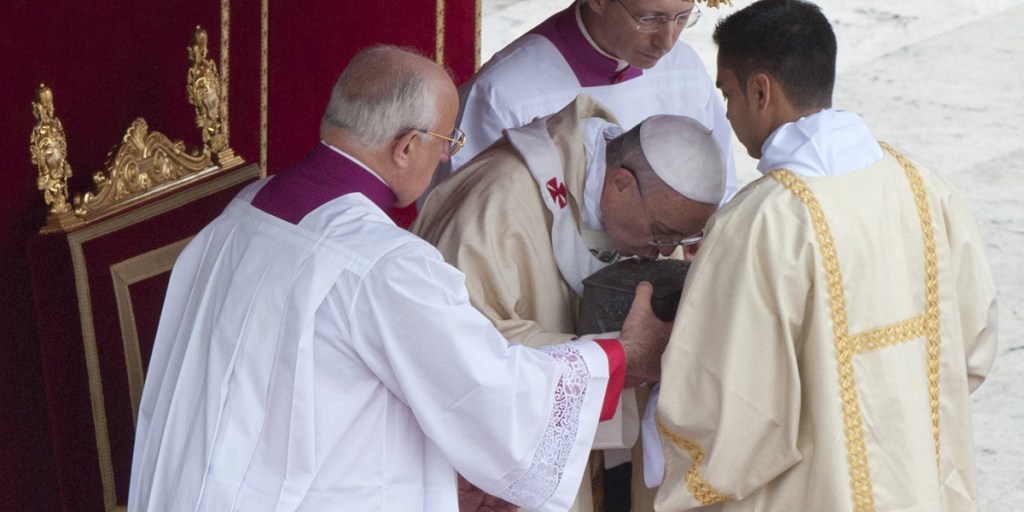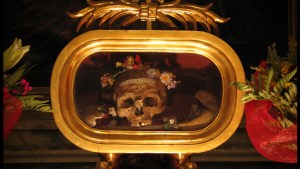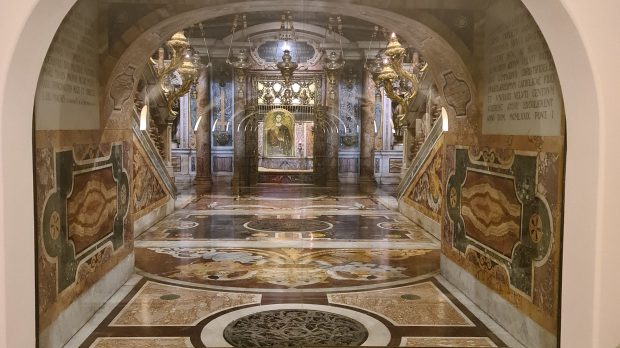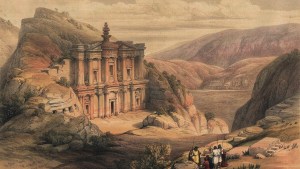Oral tradition has always taught that the Emperor Constantine built the first St. Peter’s Basilica on the same site as the tomb of the first pope. Until the 20th century no attempt had been made to validate or invalidate this belief. People of faith relied instinctively on the teaching handed down from generation to generation. But in 1939, a fortuitous event triggered archaeological excavations and involved Christians and scientists in a veritable Indiana Jones saga.
Today’s St. Peter’s Basilica has a lower level called “the Vatican Grottoes,” where many popes are buried. The floor level of these caves corresponds approximately to that of the first basilica, built by Emperor Constantine in the 4th century.
The initial discovery
At his death in 1939, Pius XI expressed the wish to be buried in these grottoes, together with Pius X. Despite the overcrowded conditions of the site, the new Pope Pius XII was eager to respect the last wishes of his predecessor. So he decided to lower the pavement of the caves, in order to enlarge the space dedicated to the future mausoleum. While carrying out the work, the workers discovered an empty space under the pavement where the remains of a funerary building could be seen. Thus a third level appeared, that of a vast Roman necropolis.
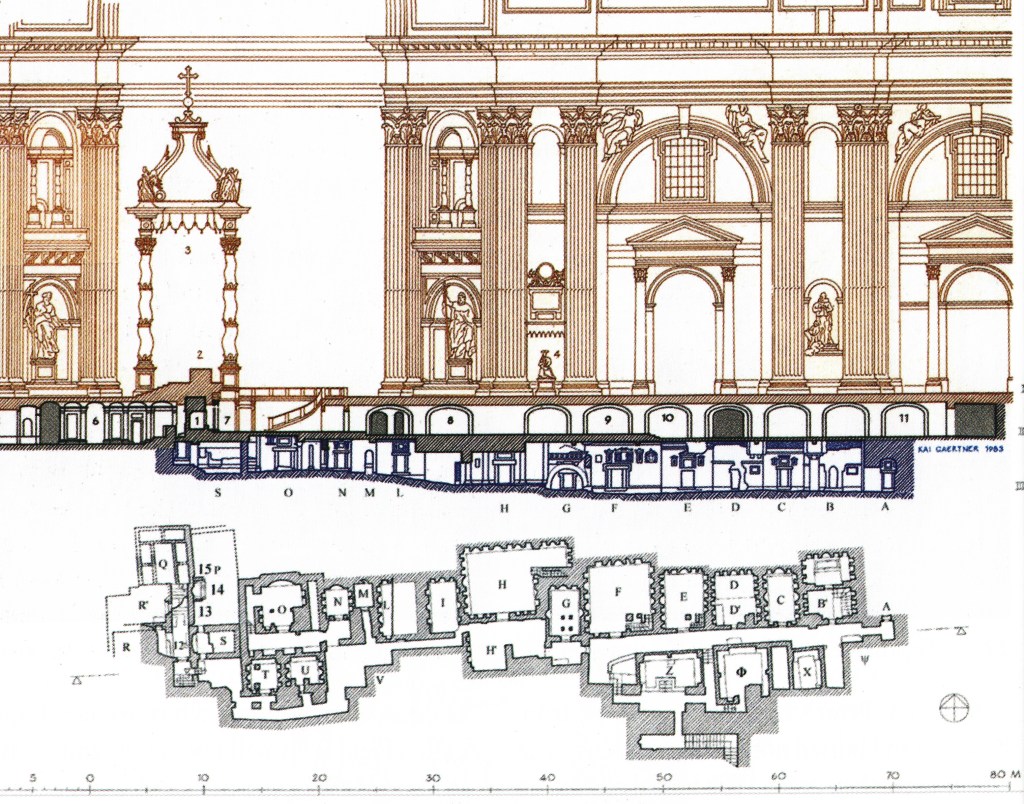
Pius XII had always been interested in Christian archaeology, seeing in it, rightly, an excellent way to bring to life the writings of the proto-Christian era. Consequently, he ordered the continuation of research and launched archaeological excavations with the best specialists, archaeologists and exegetes working together.
In total, two excavation projects (1940-1947 and 1953-1957) made it possible to explore, under the basilica, one of the richest and best preserved Roman necropolises, dating back to the 1st and 2nd centuries AD. Archaeologists discovered 22 large tombs, as well as hundreds of smaller tombs, on both sides of a narrow alley.
But the most spectacular discovery, the one that has since aroused historical attention and religious devotion, is of course the discovery of the tomb of St. Peter. In fact, archaeologists unearthed, directly beneath Bernini’s high altar, the remains of a small funerary monument built in the mid-2nd century and which has turned out to be, in all probability, the tomb of the first pope.
Burying the martyrs not far from their place of death
As early as the end of the 1st century, Christian sources mention the martyrdom of Peter in Rome: His arrest and execution took place under Nero, after the fire that ravaged the city in 64. The Acts of Peter, an apocryphal text, recounts the crucifixion of the apostle (with his head downwards) in the circus of Caligula, which had just been restored by Nero.
This circus was located on the outskirts of Rome at the foot of the Vatican hill, on which a vast cemetery extended where pagan and Christian tombs rubbed shoulders. There’s no doubt that the Christian community of Rome came to claim the body of Peter and bury him with dignity, as authorized by Roman law after an execution.
At that time, Christians used to bury the martyrs in the vicinity of the place of their death, no doubt to facilitate the transmission of the memory of the places. On the other hand, they were still following the Jewish law, which prescribes that the deceased should be buried as soon as possible. Therefore, Peter was certainly, like Christ, buried in the cemetery closest to the place of his execution, in a place that belonged to a Christian.
Early testimonies
The first mention that has come down to us of the tomb of Peter on the Vatican hill dates from around the year 200. It’s found in a letter sent by the priest Gaius to a certain Proclus. He explains that the apostles Peter and Paul are buried in Rome, the former in the Vatican, the latter on the road to Ostia: “Obviously I can show you the trophies of the Apostles. If you want to go to the Vatican or on the way to Ostia, you will find the trophies of those who founded the Roman Church.” In this text, the word “trophy” designates the monument built over the tomb, a monument that represents the reward of the martyr, the victory of eternal life over death.
As Christophe Dickès explains in his excellent biography of St. Peter, the text of Gaius and the monument discovered under the basilica confirm each other, and add credibility to the tradition of the Church, the fruit of a very long oral and written tradition dating back to the first century.
Ancient bones
But the story doesn’t end there. One day in 1941, Msgr. Kaas, one of those in charge of the excavation, was making his daily tour in the company of the leader of the workers. Out of respect for the deceased, Msgr. Kaas was particularly attentive to ensure that the numerous human bones unearthed were collected and piously preserved.
Thus, each batch of bones was carefully logged and recorded in an individual box. While taking stock of the day’s work, the two men discovered human bones in a sort of secret cavity, or loculus, excavated in one of the walls of the now well-known small funerary monument, which became known as the “trophy of Gaius.”
This cavity is striking because it’s lined with marble slabs. Msgr. Kaas carefully collected the one hundred human bones and placed them in a numbered box, which was then placed together with the other boxes in a shed. It was then forgotten for several years.
Absolute surprise
During the second period of excavation, an epigrapher removed the box and sent the bones to the laboratory. The analysis revealed that they belong to a single male individual, of robust constitution despite his arthritis, aged 60 to 70 years at the time of his death. This description could very well correspond to Peter.
Along with these analyses, the epigrapher noted on the wall of the loculus an inscription in Greek — Petro Eni — that can be translated as “Peter is here” or “Peter rests in peace.” These discoveries resounded like thunder in the scientific world and in the Christian world: Archaeologists believed they have found not only the tomb of St. Peter, but also his holy remains.
Therefore, archaeological findings, architectural findings, and biological analyses are consistent with the ancient testimony of Gaius. But, even more simply, all this work and research is in agreement with the Tradition of the Church. In fact, the Basilica of Constantine was built on and around the tomb of Peter. The people of the Renaissance, at the time of the reconstruction of the basilica, perfectly respected the popular belief, despite not having any material evidence. And, centuries later, the venerable tomb was found directly below Michelangelo’s dome and Bernini’s altar.
The relics of the holy apostle and first pope were exposed for the veneration of the faithful for the first time in 2013. Six years later, Pope Francis, in a profound gesture of unity, offered part of the relics of St. Peter to Patriarch Bartholomew. Now honored in Rome and Constantinople, these relics constitute a strong historical bond between Catholics and Orthodox.
